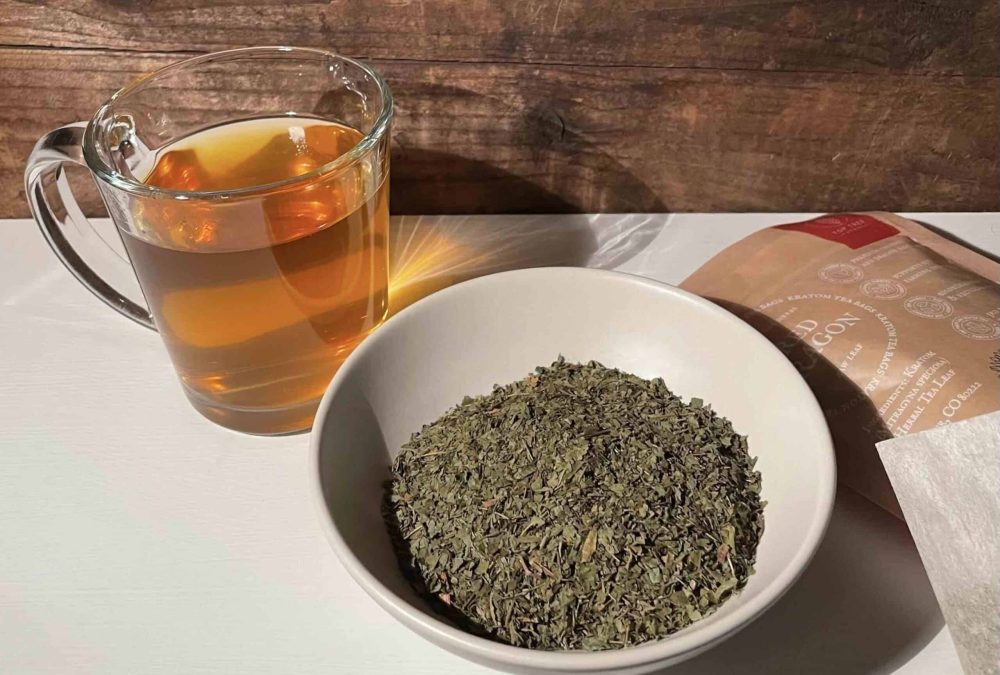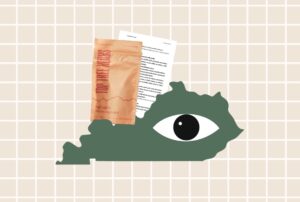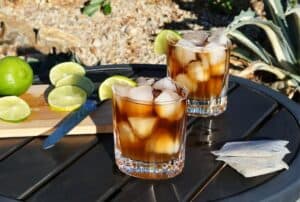If you’ve ever asked, “what’s the best way to take kratom powder?“, chances are, you’ve gotten a wide variety of answers.
People have come up with numerous different methods for eating kratom powder. From the old “toss-and-wash” method to blate plates, people have been trying for years to find the best way to eat kratom powder. Now, in Southeast Asia—where kratom grows naturally—people have consumed kratom for centuries. So, what’s the traditional method of taking kratom powder? How do people in countries like Indonesia and Thailand eat kratom?
Well, the answer is—they don’t, at least not regularly. Most powdered kratom is produced for the United States market. People have not swallowed kratom powder for more than a few decades. Conversely, forms of eating kratom like chewing fresh kratom leaves or drinking kratom tea have been around for centuries. So, since you can’t look at the history of kratom use to find out how to consume kratom powder, what should you do? Should you learn how to make kratom tea from powder or find another means?
The Perplexing Questions of How to Consume Kratom
Here are some of the common questions that people ask when considering making kratom powder tea, which you’ll find many answers to below:
- Is kratom tea stronger than powder?
- Is kratom tea stronger than capsules?
- Is kratom tea better than toss and wash?
- Is kratom weaker if you mix it with a smoothie, or take it as a slurry?
- What’s the best way to consume kratom powder?
- Is kratom powder stronger than kratom tea, and if so, how do you make kratom tea as strong as powder?
Kratom Serving Size [Infographic]
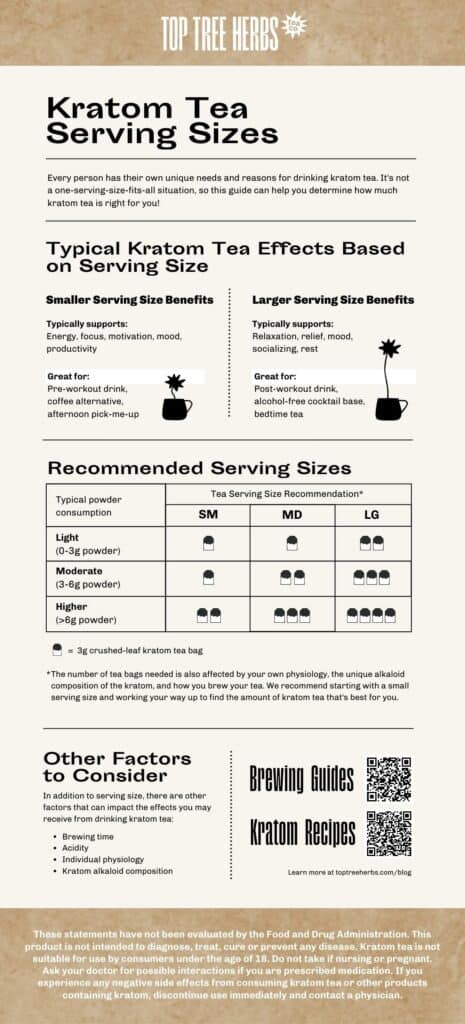
People frequently ask us these general questions. While many people can easily give a quick answer based on their personal experiences, the answer is relatively complex when you consider how individuals and circumstances differ.
These are some of the main factors we consider when answering the questions about eating kratom powder or drinking kratom tea:
- Kratom’s history of use outside of the U.S.
- Why Americans mostly consume kratom powder
- Kratom botany and chemistry
- Brewing methods for kratom tea
As we’ve learned, people often ask these questions if they’ve brewed kratom powder tea, and it didn’t work. They’re great questions because they stem from real experiences. When your kratom tea isn’t effective, it’s easy to draw the conclusion that when it comes to kratom tea vs. powder, kratom tea must be weaker. If you ask us if kratom tea is weaker, our answer is simple: it depends on how you brew it.
If you prepare kratom tea properly, it can satisfy anyone’s strength preferences, even if you’re used to powdered kratom.
Let’s first get into the historical and scientific context for drinking kratom tea, and then we’ll discuss how kratom tea compares to other forms of kratom.
How To Use Kratom Around the World
As the first kratom tea bag company in the world, we’re here to help you learn how to make a proper cup of kratom tea.
There are many reasons the American market has remained indifferent to the traditional methods of kratom consumption for such a long time. In the United States, kratom use has remained relatively unknown. It first started gaining popularity as GIs returned from Vietnam, having tried it while deployed. Yet, it only really entered into the public consciousness following the beginning of the administrative crusade against it in 2012.
In classic American cutting-to-the-chase style, most kratom is now sold as whole-leaf powder for a crude and quick intake. Throughout Thailand and Malaysia, however, kratom users typically chew on leaves or brew them as a tea. In these regions, brewing and drinking kratom tea is a tradition that spans many centuries.
Kratom Tea vs Powder
Profit-Motivated Product Options
We believe that Americans consume kratom leaf powder because it’s what most vendors sell, as powder is what brings them the most profit.
As consumers, we’ve become accustomed to it, especially since ingesting whole-leaf powder can be very quick and easy to do (though it isn’t necessarily pleasant). In the United States, people tend to gulp or choke down unpleasant piles of leaf powder, otherwise known as the “toss and wash” method of taking kratom powder.
Yet, Thai communities have inherited a many-hundreds-of-years-old tea-drinking tradition. Though powder has some benefits, Americans haven’t actually discovered a better way to use kratom.
Drawbacks of Kratom Powder
In reality, the “benefits” of ingesting powder are shortsighted. It may sound great to be able to consume kratom in a matter of seconds, but it has longer-term drawbacks. Eating powdered kratom leaves has left people feeling uncomfortable in a wide range of ways.
Some of the recorded concerns are stomach discomfort, “the wobbles,” and other maladies. Eating kratom leaf powder instead of making a tea can save you 15 minutes. But are those 15 minutes worth the grab bag of unnecessary side effects?
In many ways, these side effects stem from consuming small piles of dried plant matter—which would be avoided if you strained out the plant material, as is done when making tea. For those who are affected most by these symptoms, taking leaf powder is off the table completely—but tea is a great alternative. When it comes to kratom tea vs powder, you do not consume any solids with tea, and can thus bypass or limit the negative effects of swallowing the leaf material.
When done correctly, brewing tea with kratom results in no difference in strength than eating the leaf powder directly.
Some individuals in Thailand mix kratom with other ingredients we wouldn’t recommend. Hyper-sensationalized news stories share the legend of an ultra-strong form of kratom tea mixed with cough syrup, which we cover below.
Two Thai Teas: THE LABORER’S SECOND WIND
For a traditional tea, laborers add about 5 kilograms (11 lbs) of fresh kratom leaves to a large pot of water. They heat the water and kratom leaves over a fire for about four hours. After lunch, they divide the tea, and everyone enjoys their afternoon energy boost.
They intentionally drink this tea in the afternoon to give them a second wind for completing their work. The laborers take their teas with them back into the rubber tree groves or to their farms. They continue their work, though now with kratom-tinted smiles.
Chewing Kratom Leaves vs. Eating Kratom Powder
While tea seems to be the preferred way to reap the benefits from kratom, people often chew on the leaves as well. It is not uncommon to see someone pluck a leaf, remove its central vein, and chew the quid for 10 to 15 seconds before spitting it back out.
How does this work? In short, membranes in the mouth absorb the kratom alkaloids. The onset of effects is fast and very noticeable.
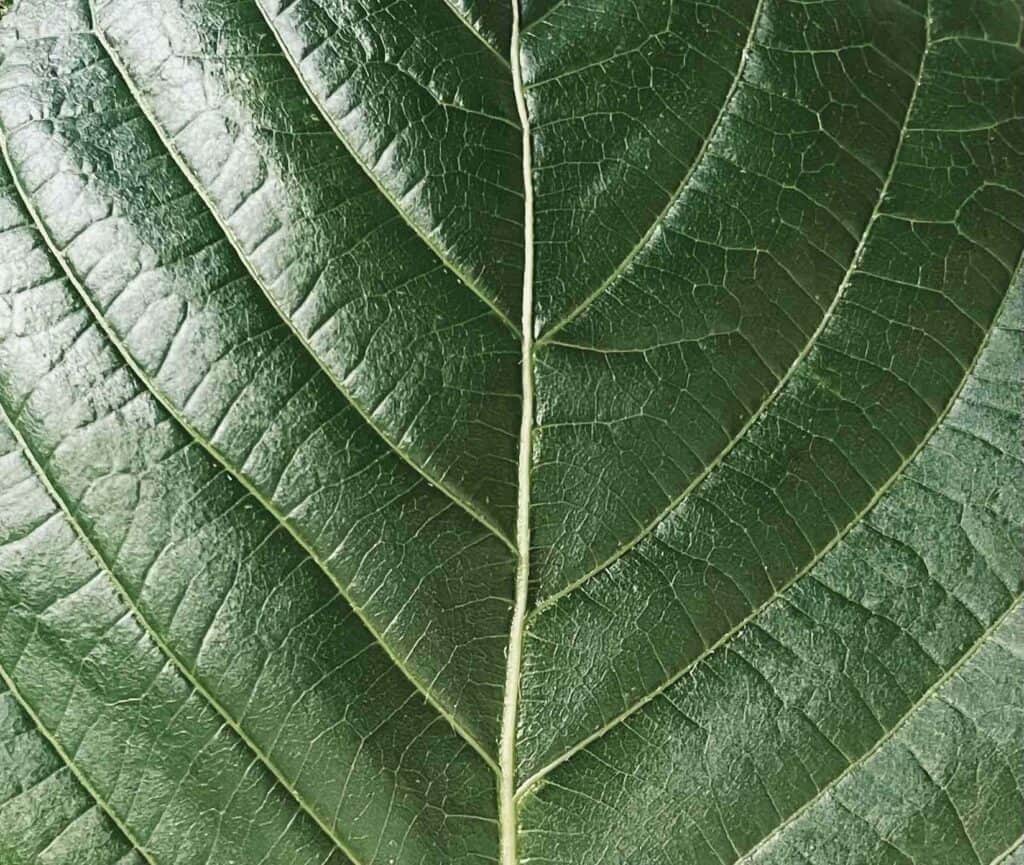
When it comes to kratom leaves vs powder, it’s more traditional and versatile to chew kratom leaves. They’re less prone to causing effects like wobbles. While you can make tea from both kratom powder and kratom leaves, it is much easier to do so with either dried whole kratom leaves or dried, crushed-leaf kratom leaves.
Interestingly, while many Americans eat the actual kratom leaves when they take kratom, there is no traditional preparation that we are aware of that involves swallowing any of the kratom leaf matter. Furthermore, while these laborers are the figureheads of traditional kratom use, they’re not the only users of kratom tea in modern Southeast Asia.
Pleasure and the Puritanical Response
After work is over for the day, an entirely different brew is made from the ones mentioned above. The media refers to it as “4×100,” a youth drug of abuse. This “toxic cocktail” was and continues to be sensationalized by local and global news outlets. Their stories are complete with all the pickings of the post-Reagan-era drug hysteria.
So, what exactly is the 4×100 kratom drink? Many articles report that kratom 4×100 is named after its four ingredients: kratom, soda, cough syrup, and rice.
Other articles report that sometimes these kratom cocktails are dangerously mixed with adulterants such as methamphetamine, opiates, and benzodiazepines. In the wake of consuming 4×100 was (allegedly) addiction, withdrawal, and insanity. The mainstream coverage of the drink manufactured panic, in the typical manner of reporting on any of the substances that fit drug war narratives.
Deconstructing the Sensational
Reporter on all things strange, Hamilton Morris investigated the elicit 4×100 phenomenon in Thailand in 2017. Under the faint glow of the production team’s lights, three young men demonstrated the preparation of the infamous recipe.
Four items made the brew complete: kratom leaves, candied sugar plums, cola, and a bottle cap of cough syrup containing chlorpheniramine (an antihistamine).
Aside from the diluted, mild dose of an antihistamine, which likely adds very little to the overall effect of the drink, the recipe creates a sweet, carbonated kratom tea. So, why use the chlorpheniramine if it doesn’t contribute to the effect?
Well, it’s likely just their imitation of the media-reported recipe, not the result of any research on the effects of this combination. Oftentimes, the news influences drug-taking behavior, so this concoction might not have originated with much trial and error.
This nighttime beverage is noticeably different from its daytime counterpart in other ways, as well. Those who consumed it were looking for mood-altering and relaxing effects. The paradox of kratom’s activity in the body is that it energizes consumers when less is taken, yet makes them relaxed or drowsy after several servings.
It’s reasonable to suspect that 4×100 is simply a strong kratom tea with a lot of bad press. The sugar plum candy and cola mixture probably carries the same health risks as a high fructose corn syrup-laden American sweet tea.
Yet the lesson to be distilled from this is plain: kratom tea can be made to suit the preferences of those who make it. A weak tea is frequently made to reinvigorate the weary muscles of the common laborer. A strong tea may be brewed for more recreational purposes, for pleasure instead of work.
That is to say, kratom tea can be any strength you like!
The Virtue of Patience
Though making a more traditional cup of kratom tea requires a slightly greater investment of your time than taking kratom powder, it’s well worth it. While making your tea, you are also taking the time to practice patience and mindfulness. You are showing that you are worthy of what is best and that you are willing to take the time to do it right. This, along with the inviting cup of kratom tea at the end, is why we believe the tea “ceremony” is a great practice to incorporate into your wellness routine.
Why try to chug down a gritty, bitter sludge of kratom powder when you can add some mindfulness to your method? You may find that you enjoy brewing kratom tea bags due to their simplicity and versatility. Besides, using pre-made bags of crushed-leaf kratom tea is a lot easier than making tea from kratom powder.
How to Make Stronger Kratom Tea
As a quick review, people in Southeast Asia make kratom tea by simmering it for hours over a fire. Yet, there are numerous methods for speeding up the brewing process. It still won’t be as quick as swallowing powder, but it’ll certainly taste better and feel more comfortable.
The Traditional Method
Want to replicate a simple traditional tea? We recommend that you place your tea bags into a pot of water a bring it to a boil. Once boiling, turn down the heat and leave the pot to simmer for upwards of 4 hours. The longer you steep, the stronger your tea will be.
When you use hot water alone for your extraction, a longer brew time is essential. This is because mitragynine, one of the primary alkaloids found in kratom, is not soluble in water.
Brew Quickly: A Modern Shortcut
Add some lemon juice to bring the time down to about 20 minutes!
Are you trying to make kratom tea efficiently and quickly? If so, we recommend that you steep your tea bags in boiling water and lemon juice.
Ultimately, our tea-making advice stems from lessons distilled from both the traditional methods of brewing and cutting-edge kratom research.
A great way to maintain the temperature is to keep it sealed in a vacuum-insulated thermos. Make sure to steep for at least 20 minutes to extract the alkaloids more completely from the leaves.
The citric acid in the lemon juice significantly increases how soluble the alkaloids in kratom are in water. This means that the brew time for a strong cup of tea is considerably shorter. Any food-grade acid helps – you don’t have to stick with lemon! Some of our favorite additions are grapefruit, blood oranges, and satsumas. We definitely recommend that you experiment with the fruits that are available to you.
Making Enough to Last
It’s hard to make a good cup of kratom tea in a very short time. Given that we live in a much busier world than the originators of the traditional brewing method, we sympathize with those whose lives demand the occasional rush.
You can buy a large tea thermos or kratom carafe to streamline your brewing practice when you’re too busy to simmer your tea bags on the stove. This way, you can batch brew enough tea to get you through the day, or even a few days!
1 to 5 tea bags (1 serving size) can replenish energy levels. 3 or 4 servings of kratom can reverse that course. Instead of increasing energy, the tea promotes a sense of wellness, comfort, and relaxation.
Is Kratom Tea Weaker? No!
A properly brewed cup of kratom tea can be as strong as consuming the whole leaf.
When you don’t want to take the time traditionally allotted for brewing kratom tea, you can simply add an extra tea bag and some acidic fruit juices in a thermos until you’ve reached your desired strength per cup.
Compared to kratom powder tea, crushed-leaf kratom tea is faster, simpler, and easier to make—and it’s a lot closer to the traditions that gave us kratom in the first place.
However you spin it, the answer regarding the strength of kratom tea is all in how you brew it.
